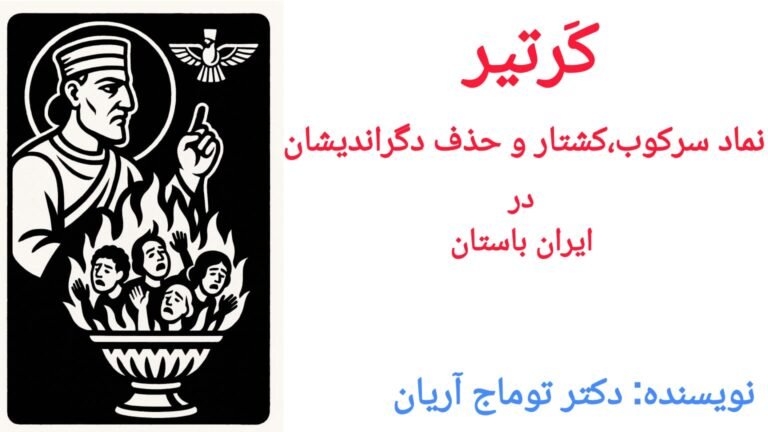Author: Dr. Tomaj Arian*
Kartir, son of Kabag, was a Zoroastrian priest and influential minister in the Sasanian dynasty.
Kartir was a minister during the reigns of Ardashir I, Shapur I, Hormuz I, Bahram I, and Bahram II of the Sassanid dynasty, and was the most influential and influential person in the Sassanid dynasty.
He lived a very long life, and his birth date is stated to be between 180 and 200 AD, and his death was after 293 AD.
Kartir is the only non-royal person in Iran who has independent epitaphs of his own, demonstrating his influence and status.
He has three epitaphs in Naqsh-e Rajab, Naqsh-e Rostam, and Sar-e Mashhad, in which he discusses his actions and the work he has done.
I will present the Persian text of the inscriptions of Naqsh-e Rustam, Naqsh-e Rajab, and Sar-e Mashhad, which were written and built by Kartir, below, so that we can see a clear picture of Kartir and his religious repressions.
1. Naqsh-e-Rostam:
“I, Kartir, Mobadan Mobad, son of Kabeg, who served during the reign of the great kings, Ardashir Shah, Shapur Shah, Hormuz Shah, Bahram Shah, and Bahram II Shah,… I spread the religion of Mazdasena, built fire temples, founded religious courts and tribunals…”
“I suppressed false religions; I destroyed or expelled Nestorians, Jews, Manichaeans, Buddhists, and atheists, and I spread Zoroastrianism throughout the empire.”
“In the mountains, in the deserts, in the farthest corners of Persia and other lands, I lit a sacred fire and established the Ahuraic law. I trained and rewarded the priests, so that they would return the people to the true path.”
2 Naqsh-e Rajab:
“I, Kartir, Mobadan Mobad, son of Kabag, have served during the time of the great kings. Ardashir, Shapur, Hormuz, Bahram, son of Shapur, and now Bahram Shah Zozorg, son of Bahram.
I established and promoted the religion of Mazdaism, suppressed false religion, and guided people from error to the path of truth.
I lit many sacred fires, appointed priests, and spread justice among the people.
“The great Shah Bahram honored me greatly and ordered me to spread religion throughout the country and establish a religious court. I am happy that I have done these things for the souls of the past kings and Bahram Shah, and I will receive a reward from Ahura Mazda.”
3 Secrets of Mashhad
“I, Kartir, Mobedan Mobed, son of Kabeg, who served during the reign of Shah Shapur the Great and the kings after him…, have been commanded to travel to distant provinces, establish sacred fires, and spread the religion of Mazda worship throughout Iran.”
“I went to Sistan, Zarang, Kushan, Tapuristan, and Khorasan and spread the religion of Mazda there. I converted the people of those lands from false religions. I built fire temples, and I trained the native priests.”
Kartir’s actions are very diverse, and the goal of his actions was the complete and comprehensive expansion of Zoroastrianism in politics, culture, religion, and society, and during his time, religious repression and dissidents reached their peak.
During the Cretan era, Christians, Jews, Manichaeans, Buddhists, Brahmins, and atheists were subjected to severe pressure. Many of them were killed, and most of their temples were destroyed and replaced by fire temples.
He was the main architect of the compilation of the Avesta, and during his time, the various parts of the Avesta were gathered and brought into the form you see today.
His influence reached such a level that he interfered greatly in the removal and appointment of officials and the status of princes.
During the reign of Bahram II of the Sassanid dynasty, Kartir became the Mobed Mobedan, the highest Zoroastrian religious position.
During the time of Kartir, many fire temples were built, old fire temples were renovated, and all non-Zoroastrian temples were forcibly converted into fire temples.
During the time of Kartir, the official Zoroastrian state institution was formed and gained power, and until the last day of the Sassanid dynasty, the Zoroastrian state institution participated in all state and government affairs and played a decisive role in the removal and installation of kings.
Kartir practically forcibly made Zoroastrianism the official religion of Iran and placed the laws, courts, and judges under the jurisdiction of Zoroastrian priests, and the laws were implemented entirely based on Zoroastrian jurisprudence.
With his great power, Kartir only ruled over the Zoroastrian narrative and began a bloody struggle with other religions, which led to the destruction of religious diversity in Iran and religious repression. This repression was mainly directed at Manichaeans and Christians, who were expanding religions.
Kartir considered any religious tradition other than the main branch of Zoroastrianism to be false. He even suppressed the Zoroastrian branches such as the Zurvaniya, the independent Maghans or Zoroastrian Mehrists, heterodox Zoroastrian groups, and local and indigenous Zoroastrians, and no trace of them remained in history.
During the time of Kartir Mobed, the Mobedan, the highest religious authority, and the highest executive authority were united, and religion was placed at the head of the government system, and the first religious government system was formed.
Kartir considered his mission divine, considered himself the messenger of Ahura Mazda and his orders the result of Ahura Mazda’s orders, and officially established a state religion and a connection to the divine source in the government.
During the time of Kartir, justice fell into the hands of Zoroastrian priests and all laws were changed based on Zoroastrian jurisprudence.
The Kartir divided society into several parts and created a very strong and inflexible class structure that remained until the last day of the Sasanian rule and was the source of many major uprisings during the Sasanian rule. In this class system, even marriage with one class and class was prohibited, and the houses and shops of each class and class were separate from each other in the cities, the effects of which could be seen even 50 years ago in Iran. In the old markets, there were orders of shoemakers, bazaars, etc., which were all concentrated in one order and did not operate in other markets.
The emergence of new religions during the Sassanid dynasty, especially after the ministry of Kartir, was the result of religious pressure and the implementation of class hierarchy on Iranian society, which created the Manichaean religion and later the Mazdakism, and Christianity gained great popularity during the Sassanid era. These religions were suppressed throughout the period after Kartir, and there was a lot of religious killing in Iran. There are three major examples of religious killings during the Sassanid era, two of which were during the ministry of Kartir: the killing of Mani and Manichaeans and the killing of Christians. And later, during the time of Qobad and Anushirvan, the killing of Mazdakists and their widespread massacre throughout Iran.
Basically, the emergence of new religions is the result of intense religious pressure, class hierarchy, and discrimination, of which the Sassanids are a real example. During the Sassanid era, two prophets and a new religion emerged in Iran, and Christianity also penetrated to the easternmost parts of Iran, bordering China. We have not witnessed the emergence of new prophets and new religions in any period in Iran. The next example is the ineffective Qajar dynasty, in which the Baha’i religion emerged. New religions and mystical sects and dervishes in Iran are the result of a deadlock, of which the Sassanid example is a complete and historically proven example.
All Sasanian kings after the period of the minister of Kartir had problems with the influence of Zoroastrian priests in the government, and this issue led to the killing of the king’s successors and influence in the selection of the next successor, and caused numerous coups within the Sasanian dynasty, which also led to the fall of the Sasanian dynasty. A prominent example of this was the Sasanian king Qubad I, who was twice coup d’état by priests in the capital.
Qobad I even appealed to the Byzantine (Eastern Roman) Emperor Justinian I to secure his successor, Khosrow Anushirvan, and asked them to guarantee his son’s successor, which indicated a crisis in the government and the influence of Zoroastrian priests in the Iranian government and society.
After Qobad, Khosrow Anushirvan massacred all Mazdakis to attract the attention of Zoroastrian priests and burned Mazdaki alive, and all Mazdakis were publicly stoned, burned, or buried alive.
The massacre of the Mazdaks is considered a great example in world history of mass killings based on belief.
Contrary to the tolerant perceptions of ancient Iran, we see no trace of religious tolerance in the Sasanian dynasty, and the undisputed ruler of religion in Iran is Zoroastrianism.
During the time of Kartir, the concept of a legitimate king emerged, meaning a king who was approved by the Zoroastrian religion and who derived his divine and earthly legitimacy from religion.
The next concept that became popular during the Cretan period was religious justice, which led to the establishment of religious courts and the enforcement of religious laws by judges who were priests.
Conclusion:
Contrary to the popular perception of ancient Iran and the Sasanians as a tolerant society, historical evidence, including the inscriptions of the powerful Sasanian vizier Kartir, suggests a different reality: a religiously-centered, authoritarian government based on a totalitarian religious ideology.
Kartir not only initiated the era of religious dominance over politics in Iran, but also laid the foundation stone for a system that sacrificed religious diversity, freedom of belief, and social justice for a religious agenda.
Resources:
- Boyce, Mary. Zoroastrians: Their Religious Beliefs and Practices. Routledge, 1979.
- Pourshariati, Parvaneh. Decline and Fall of the Sasanian Empire. I.B. Tauris, 2008.
- Zaehner, R. C. The Dawn and Twilight of Zoroastrianism. Phoenix, 1992.
- Wiesehöfer, Josef. Ancient Persia. I.B. Tauris, 1996.
- (History of the Wars). ترجمه انگلیسی: H.B. Dewing. Harvard University Press, Loeb Classical Library، 1914–1940.
1. Procopius. History of Wars. Persian translation of chapters 11 and 23 for the story of Qobad, Khosrow and the suppression of the Mazdaks.
2. Christensen, Arthur. Iran under the Sassanids. Translated by Rashid Yasemi. Tehran: Zavar Publications.
3. Tabari, Muhammad ibn Jarir. History of the Messengers and the Kings. Translated by Abu al-Qasim Payanda.
4. The Horse of a Thousand Judges (Matikan Hezar Dastan). Translated by Bahman Sarkarati. Tehran: Iranian Cultural Foundation, first edition, 1977.

